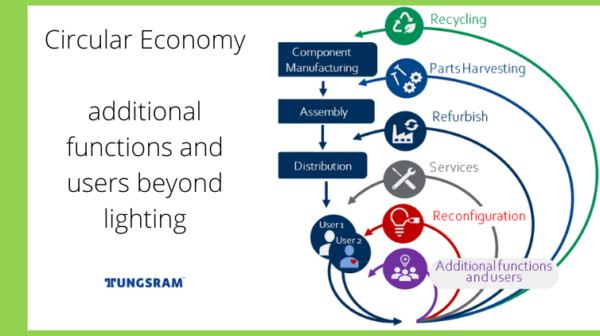Webinar summary | Number 2 in Recolight’s Lighting & the Circular Economy series
How the lighting sector can reduce its environmental impact
The second Lighting and the Circular Economy webinar, organised by Recolight, was held on 14 July 2020. Introduced and chaired by Ray Molony, speakers challenged the industry to set ambitious goals and explore how innovative product design can have a positive impact on sustainability.
Standards that will change lighting
Ray Molony , Online editor of Lux Review, started with a recap of the first Recolight Webinar in the Circular Economy series, this included:
- Defra’s strategic aims for a circular economy which was presented by James Butterworth and Matt Stocks.
- Ourania Georgoutsakou of Lighting Europe’s presentation on how EU laws and policies on sustainability are impacting lighting products.
- Nigel Harvey’s outline on the impacts of the Government’s Resources and Waste Strategy , UK WEEE, waste packaging and battery legislation.
Ray included a reminder that new legislation will require manufacturers to change their designs so that light sources and gear can be replaced by either the user or a qualified technician. Along with the new pictograms that will start appearing on luminaires, showing which products can be serviced by the user and which require a technician
Reducing environmental impact

Environmental campaigner and lighting designer John Bullock of The Light Review challenged the industry to commit to dramatically reducing its environmental impact. He delivered powerful, thought provoking concepts and ideas, including suggestions of how business in the lighting sector should change such as reduced use of air and car travel.
Product design at the heart of the Circular Economy
With product design at the heart of the Circular Economy, luminaire designer Simon Fisher, Director, F Mark Ltd, discussed practical considerations needed to design and manufacture lighting products.
He told us that we can influence and adopt CE thinking via product design with certified material sourcing, redefining packaging strategy and embracing closed loop manufacturing.
Innovation, sustainability & the circular economy
Richard Garrett, Marketing Manager, Signify, looked at Innovation, sustainability & the circular economy. He explained that partnering with sustainable suppliers is helping them to become a fully carbon neutral organisation.
Richard outlined five key pillars for luminaire design in a circular economy :
- Modular Design, which includes standardised components utilising the relevant Zhaga book
- Upgradable, not just a driver and board upgrade, but also upgradable to a connected system.
- Disassembly – Simple disassembly during the process of upgrading or recycling should take fewer than five steps.
- Easy to maintain – Lower failure rates due to higher quality and more efficient spare parts and asset management. The ability for a digital twin to be embedded into a building management system would also allow for predictive maintenance based on real time luminaire usage.
- Recycling – Product breakdown should happen easily with different materials being easily separated.

He concluded with the carbon savings of producing 3D printed products verses metal and aluminium die cast, and other benefits of tailored design, scalable solution, and quality.
Sustainable lighting solutions and challenges
Zoltan Pilter of Tungsram discussed sustainable lighting solutions and challenges. He explored the concept of lighting products designed for circular economy being extended, through their hardware and software, to connect into new value chains. For example: installing sensors, such as radar or weather or road conditions monitoring sensors, extending use of existing network connections to other users (e.g. 5G data service or weather monitoring).
 1.Recycling: recycle materials to bring back into the economy.
1.Recycling: recycle materials to bring back into the economy.
2. Parts harvesting: recover valuable parts to sell/use in other products.
3. Refurbish: re-manufacture products at end of life to sell again.
4. Services: extend technical & economic lifetime of products.
5. Reconfiguration: tailoring product during installation or use phase, original function remains unchanged.
6. Additional Functions and users: use existing hardware, software, data beyond lighting.
Sustainable raw materials based on renewable resources
Russell Parr of Primelight and Torsten Werner of extrusion specialist Elkamet discussed the use of sustainable raw materials based on renewable resources. Russell outlined the sustainable goals of Primelight, explaining why they partner with Elkamet.

Torsten proposed some viable alternatives to oil based plastics based on renewable resources, contributing to a more sustainable plastics industry. Materials used include cellulose, sorbitol, and other plant based products such as castor oil and tall oil (obtained during wood processing).

Concluding the session Ray Molony noted that
‘There’s a clear direction of travel now towards sustainable luminaires with replaceable parts so I think it’s crucial that lighting manufacturers start planning now for a more circular economy’




